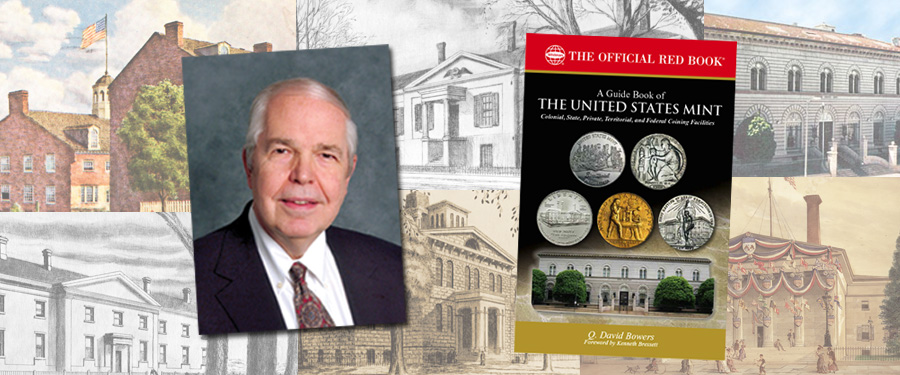
operations of the mints in the United States has always been fascinating to me.
Over the years I have visited all that were currently in operation, including
Philadelphia, Denver, San Francisco, and West Point. Along the way I have
gathered many historical news clippings, pictures, and more. On April 2, 1992,
at a special ceremony held at the Philadelphia Mint to celebrate its 200th
anniversary I was the keynote speaker invited by the Treasury Department.
under the aegis of Tom Jurkowsky of the U.S. Mint, Whitman publisher Dennis
Tucker and I made in-depth visits to each mint, carefully studying their
operations and procedures and documenting our findings with photographs.
and some visits to the sites of former mints I gained information on other
mints in America, beginning with the one operated in Boston starting in 1652,
to strike Massachusetts Bay Colony silver coins, including the famous Pine Tree
shillings. Other facilities, such as the rustic mint at Pawlet, Vermont used to
strike copper coins and the secret mint operated by Captain Thomas Machin and
his associates at the outlet of Orange Pond near Newburgh, New York are long
gone, as are those of private coiners during the California Gold Rush.
Mint archives, the National Archives, help from other researchers, and years of
enjoyable study I brought all of this together in book form.
information regarding the book from the Whitman press release.
Whitman Publishing
Releases Massive New Bowers Volume on the United States Mint
Now available from
booksellers and hobby shops, as well as online, is A Guide Book of the
United States Mint, by Q. David Bowers. The 448-page softcover book has a list price of $24.95. The 23rd volume in
the award-winning Bowers Series explores the heart of American coin collecting:
the United States Mint itself, which is gearing up to celebrate its 225th
anniversary in 2017 with special coins and medals.
The U.S. Mint is the official
source of the material that numismatists collect, study, and catalog. It is the
sole manufacturer of the nation’s legal-tender coinage and national medals, and
its products are used every day by millions of Americans nationwide. As a
federal repository its facilities safeguard more than $300 billion in national
assets. It employs nearly 2,000 people, including its own police force.
This new book unearths a
treasure trove of numismatic knowledge, including the history of the
Philadelphia Mint and every Mint branch, plus colonial, state, private, and
territorial mints; information on historical and modern minting procedures; a
study and price guide of historic medals and collectibles commemorating the
Mint; data on every director of the Mint and superintendents for every branch;
and illustrated behind-the-scenes looks at the modern Mint and its facilities.
The text is illustrated by nearly 1,300 photographs, engravings, diagrams,
blueprints, and other images.
Chapters cover: early
American money and commerce; early mints in British North America (e.g.,
colonial Massachusetts and Connecticut) and the post–Revolutionary War states;
the first federal coinage; the Philadelphia Mint; the New Orleans Mint; the
Charlotte Mint; the Dahlonega Mint; the San Francisco Mint; the Carson City
Mint; the Denver Mint; the West Point Mint; the Manila Mint in the Philippines;
and private and territorial mints such as those of Templeton Reid, the Bechtler
family, and many issuers of California and Colorado gold pieces. Chapter 13
covers “Mints That Never Were”—the Cincinnati Mining & Trading Company, the
Dalles Mint in Oregon, LeRoy Henning’s nickel-counterfeiting operation in New
Jersey, and others.
Four appendices include,
among other things, a study of medals and other collectibles related to the
U.S. Mint—Assay Commission medals, Mint director medals, Philadelphia Mint
superintendent medals, service medals, Mint ledgers and paperwork, postcards,
books, and more.
Visit whitmanbooks.com
for more information.





